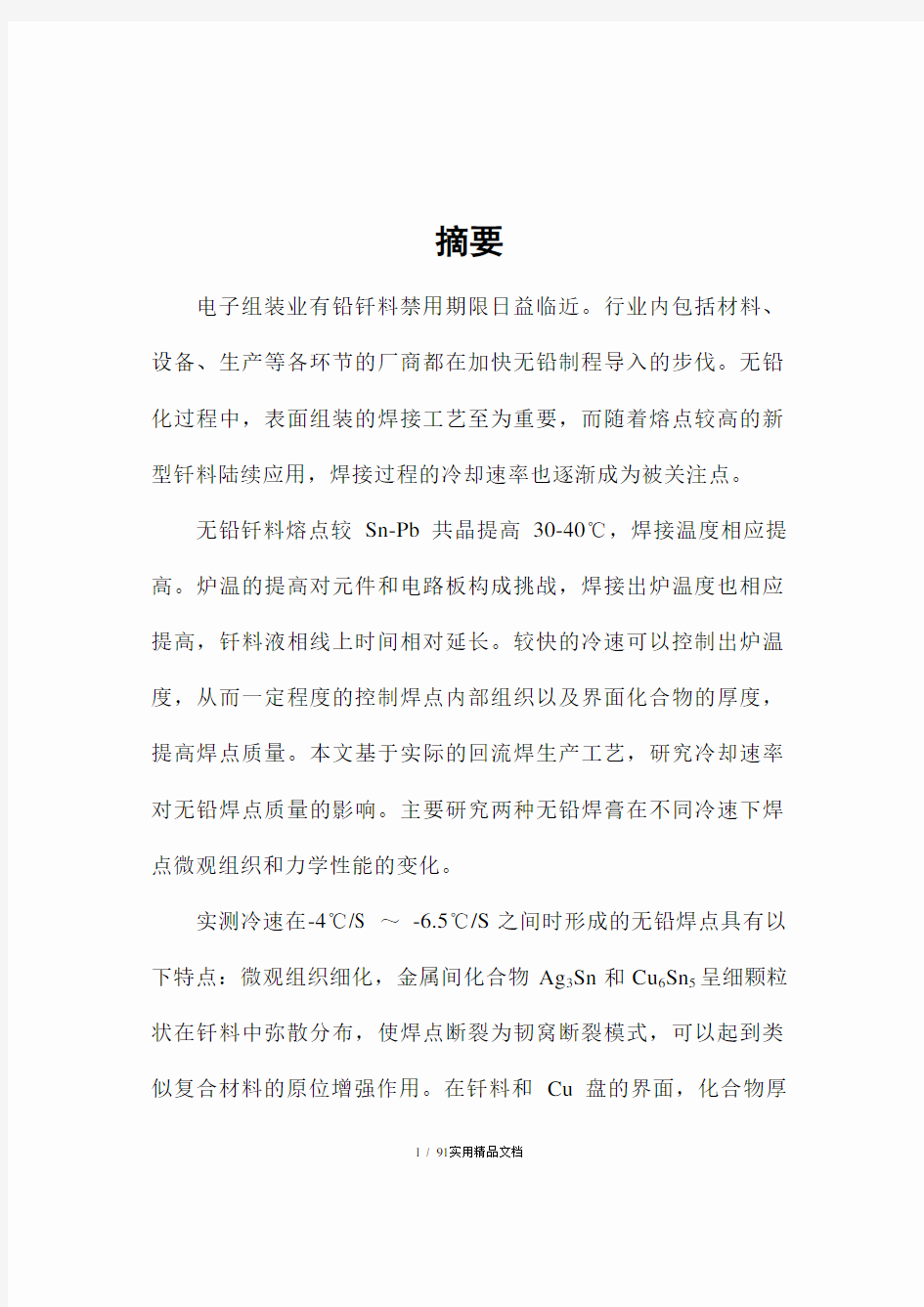哈尔滨工业大学硕士毕业论文模板


摘要
电子组装业有铅钎料禁用期限日益临近。行业内包括材料、设备、生产等各环节的厂商都在加快无铅制程导入的步伐。无铅化过程中,表面组装的焊接工艺至为重要,而随着熔点较高的新型钎料陆续应用,焊接过程的冷却速率也逐渐成为被关注点。
无铅钎料熔点较Sn-Pb共晶提高30-40℃,焊接温度相应提高。炉温的提高对元件和电路板构成挑战,焊接出炉温度也相应提高,钎料液相线上时间相对延长。较快的冷速可以控制出炉温度,从而一定程度的控制焊点内部组织以及界面化合物的厚度,提高焊点质量。本文基于实际的回流焊生产工艺,研究冷却速率对无铅焊点质量的影响。主要研究两种无铅焊膏在不同冷速下焊点微观组织和力学性能的变化。
实测冷速在-4℃/S ~-6.5℃/S之间时形成的无铅焊点具有以下特点:微观组织细化,金属间化合物Ag3Sn和Cu6Sn5呈细颗粒状在钎料中弥散分布,使焊点断裂为韧窝断裂模式,可以起到类似复合材料的原位增强作用。在钎料和Cu盘的界面,化合物厚
I / 91实用精品文档
度较小,且呈大波浪形态,容易缓解应力集中的问题,焊点的力学拉脱载荷最大;当冷速小于-1.5℃/S时,组织粗化。内部Ag3Sn粗大而尖锐,界面的Cu6Sn5呈冰凌状,且厚度较大。焊点在推剪时这成为裂纹萌生点,焊点的力学拉脱载荷最小。
关键词回流焊;冷却速率;拉脱载荷;推剪;焊点质量;
II / 91实用精品文档
Abstract
The legislation to ban the use of Pb-based solders will become effective im-mediately, which provide a driving force for enterprises to accelerate Pb-free process. It’s found that reflow soldring plays an important role in Surface Mount-ing Technology ,moreover, cooling rate in reflow soldering pro getting more and more attention after the use of high-melting-point solders.
The melting point of Pb-free solders is 30℃~40℃higher than Sn-Pb eutectic solder. The increase of temperature in reflower becomes a challenge of Print Circuit Board (PCB) and components. As a result, the Time Above Liquid (TAL) of solder joints becomes longer, therefore, fast cooling in reflow soldering is used for controlling the PCBA temperature , improving the microstructure of joints and decreasing the thickness of intermetallic compound , consequently, high quality products can be obtained.
How cooling rate affects the quality of soldering joints in lead-free process was studied in this paper. The experiments were based on practical industrial production and it focused on the effect of cooling rate on microstructure and mechanical properties.
When cooled at 4~6℃/S, the microstructure of joints were refined, the IMC of Ag3Sn and Cu6Sn5 phases disperse in eutectic network in joints which present spherical particles. The fracture of these joints after tensile failure presents dimple mode. Furthermore, the thickness of IMC was thin and it present gentle incline morphology. It
Keywords Rflow Soldring;Cooling Rate;Pulll;Push;
III / 91实用精品文档
目录
摘要........................................................................................................ I Abstract ............................................................................................. III 第1章绪论. (7)
1.1 课题背景 (7)
1.2 研究现状 (9)
1.2.1 电子组装工艺 (9)
1.2.2 无铅回流焊工艺 (12)
1.2.3 无铅回流焊中冷却速率研究现状 (15)
1.3 本文主要研究内容 (24)
第2章不同冷速的无铅焊接工艺实验 (26)
2.1 引言 (26)
2.2 试验条件 (26)
2.2.1 试验材料 (26)
2.2.2 试验设备 (29)
2.3 温度曲线调试 (32)
IV / 91实用精品文档
2.4 焊接试验结果 (38)
2.5 本章小结 (39)
第3章冷速对无铅焊点微观组织的影响 (41)
3.1 引言 (41)
3.2 无铅焊点微观组织 (41)
3.3 冷速对焊点内部组织的影响 (46)
3.4 冷速对焊点界面组织的影响 (52)
3.5 不同冷速对时效过程界面IMC生长的影响 (56)
3.6 本章小结 (61)
第4章冷速对无铅焊点力学行为的影响 (63)
4.1 引言 (63)
4.2 冷速对无铅焊点力学性能的影响 (63)
4.2.1 力学测试仪器 (63)
4.2.2 QFP焊点的力学测试 (64)
4.3 冷速对无铅焊点断裂行为的影响 (70)
4.3.1 QFP焊点拉脱断裂模式 (70)
V / 91实用精品文档
4.3.2 QFP焊点的断口特征 (74)
4.3.3 片式电阻焊点推剪的断口特征 (75)
4.4 本章小结 (77)
第5章无铅回流炉的冷却模块 (78)
5.1 引言 (78)
5.2 回流炉结构 (78)
5.3 本章小节 (81)
结论 (83)
参考文献 (84)
附录 (85)
攻读学位期间发表的学术论文 (86)
致谢 (87)
索引 (88)
个人简历 (89)
VI / 91实用精品文档
